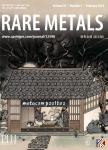Microstructure and texture evolution of Cu–Cr–Co–Ti alloys during the two-stage cryorolling
作者机构:Key Laboratory of Solidification Control and Digital Preparation Technology (Liaoning Province)School of Materials Science and EngineeringDalian University of Technology Center of Hyper-Gravity Experimental and Interdisciplinary ResearchZhejiang University Ningbo Institute of Dalian University of Technology!Ningbo315000China Key Laboratory for Light-Weight MaterialsNanjing Tech University
出 版 物:《Rare Metals》 (稀有金属(英文版))
年 卷 期:2024年第43卷第9期
页 面:4535-4547页
核心收录:
学科分类:080503[工学-材料加工工程] 0806[工学-冶金工程] 08[工学] 0805[工学-材料科学与工程(可授工学、理学学位)] 080502[工学-材料学] 0802[工学-机械工程] 080201[工学-机械制造及其自动化]
基 金:supported by the National Natural Science Foundation of China (Nos. 52271025, 51927801 and U22A20174) the Science and Technology Planning Project of Liaoning Province (No. 2023JH2/101700295) the Innovation Foundation of Science and the Technology of Dalian (No. 2023JJ12GX021) the Natural Science Foundation of Jiangsu Province (No. BK20200695)
主 题:Copper alloys Electron backscatter diffraction Macrotexture evolution Schmid factor Two-stage cryorolling
摘 要:This study entailed an investigation of the mechanical properties, microstructural and texture orientation evolutions of CuDCrDCoDTi alloys prepared via twostage cryorolling and intermediate aging treatment. To this end, X-ray diffraction and electron backscatter diffraction were employed. The results indicate that the two-stage cryorolling and intermediate aging treatments led to the development of profuse twin bundles and significantly enhanced the mechanical properties. The initial cryorolling led to coplanar slip and developed a strong Y({111} ) orientation, accelerating the formation of Goss({011} ) orientation and a Brass-type *** intermediate aging treatment relieved the restriction on dislocation slip and reoriented the grains toward the Copper({112} ) and Z({111} ) *** Z orientation, with a relatively high volume fraction,dominated the macrotexture. Secondary cryorolling intensified twinning and shear banding, transforming the Copper-type shear bands into Brass-type shear bands with rhomboidal prism morphology. The areas inside the Brasstype shear bands exhibited a Y orientation, and the areas outside the shear bands exhibited a stable Brass-type texture. The evident decrease in the weighted Schmid factors demonstrated that the two-stage cryorolling and intermediate aging treatment can modify the texture evolution and aid the design of high-performance Cu alloys.



